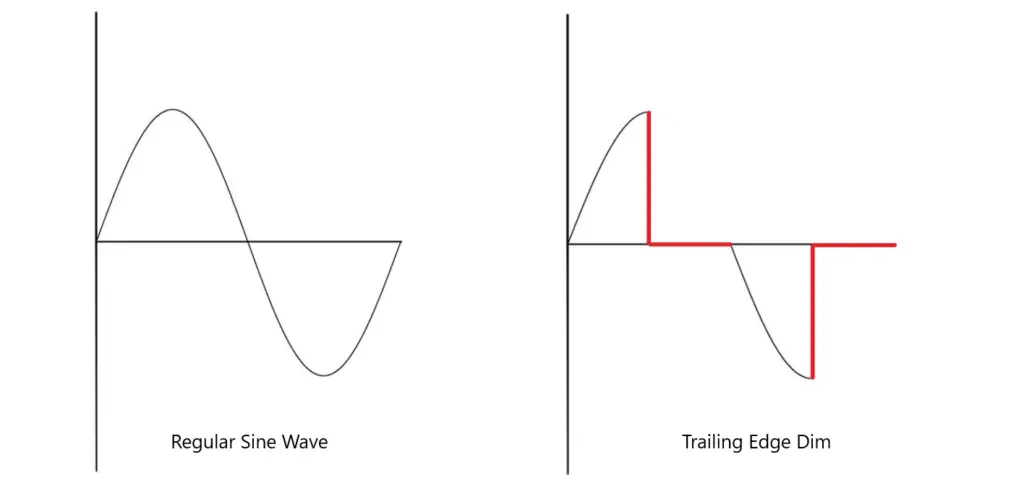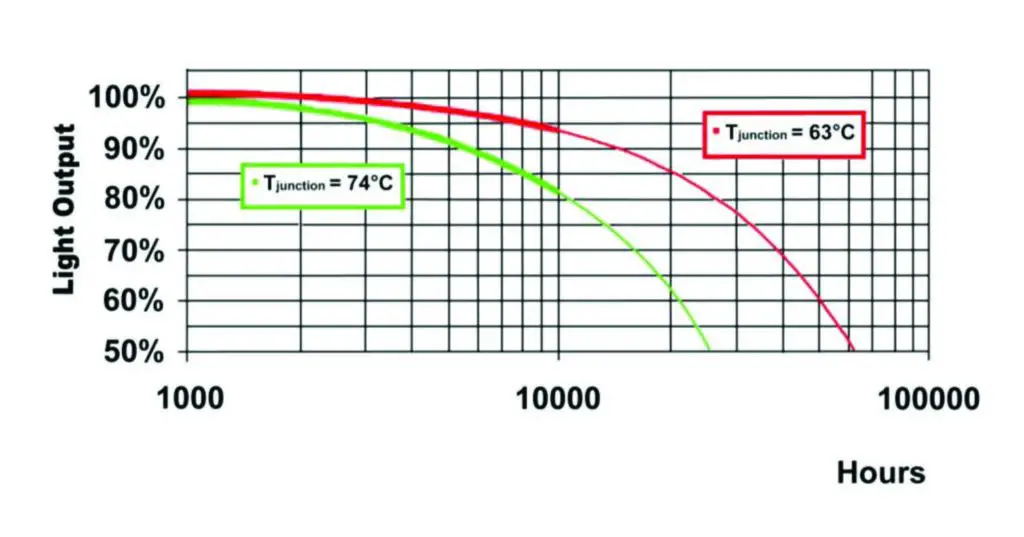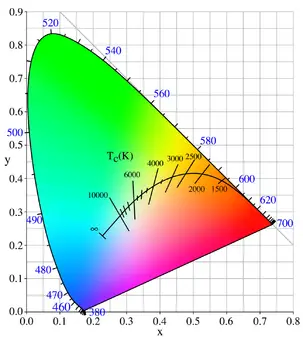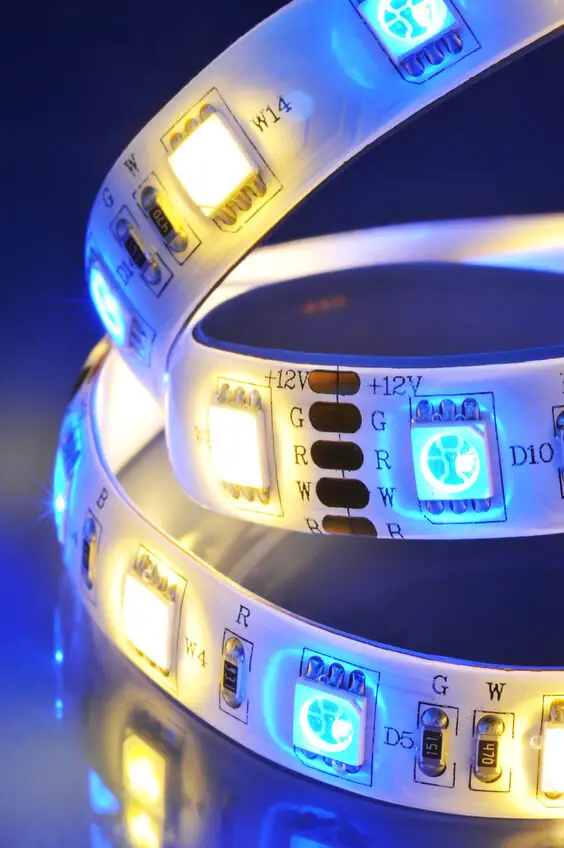Non-Dimmable LEDs On A Dimmer Switch – What Happens?
The technology of lighting has improved tons since the first light bulbs were made in the late 19th century. Today, the most advanced and increasingly popular form of home lighting is the LED as they are a very versatile and reliable lighting option.
Due to the versatility of LEDs, they are available in a lot of different variants, such as dimmable variants and non-dimmable variants.
Non-dimmable LEDs should never be put on dimmer switches due to how the dimmer can negatively affect the LED. Non-dimmable LEDs aren’t meant to be dimmed, meaning that attempting to dim them can result in flickering, overheating and reduced bulb lifespan.
While that is the short answer there is still lots more to unpack about the difference between dimmable and non-dimmable bulbs, as well as why non-dimmable LEDs suffer so many consequences when attempting to dim them.

Contents
The Difference Between Non-Dimmable And Dimmable LEDs
We have already established that you shouldn’t use non-dimmable LEDs on dimmer switches, but this answer isn’t very satisfying if you don’t know why this is. The reason for this is rooted in the difference between dimmable and non-dimmable LEDs.
The differentiating factor between these has to do with the driver they use. Almost all LEDs make use of a driver as part of their construction, which is because LEDs mainly work on a low DC voltage whereas the electricity found in our power outlets is a higher volt AC. In the bulb format, the driver is usually located inside the base of the bulb.
Because of this, it is also the driver that decides if the LED is dimmable or not. If the driver doesn’t accept a dimmer the LED, therefore, will become undimmable, whereas if the driver functions with a dimmer it will dim the light.
But what actually makes this difference? The difference in the drivers themselves has to do with its ability to understand signals and strengths between 0-100%.
Non-dimmable LED drivers understand 2 “commands” or “settings” only, which are ON/OFF. If it receives a signal which does not indicate ON or OFF it will become confused and start outputting inconsistent currents to the LED.
Dimmable bulbs on the other hand are able to understand states between ON and OFF, which normally takes place in the form of percentages. Dimmable LEDs are normally able to understand and produce light of anywhere between 0,1-100% of its max capacity.
While all of this is true for light bulbs, there is no LED which is inherently “undimmable”. The light-producing technology of LED (Light Emitting Diodes) is dimmable by default on its own. The main issue usually revolves around the ability to supply the LED with a dimmed current it can interpret and function off, which non-dimmable LED drivers can’t.
How Dimmer Switches Work
Now that we’ve established how non-dimmable LEDs operate we can look at what the actual dimmer tries to do when it dims.
There are multiple ways a dimmer may work. But there are a few ways which are fairly common. The absolute most common way dimmers work is through a process called PWM.
PWM stands for Pulse Width Modulation and it refers to the way the dimmer modulates the width of the sine wave pulse that the electrical current has. If you decrease the wave it will subsequently decrease the brightness of the light due to some of its power per second being cut off.
There are two ways PWM dimming is done, which are leading edge and trailing edge dimming. This simply refers to if we are modulating the leading edge or the trailing edge of the sine wave.

While this is the absolutely most common way dimmers tend to work there is also AWM dimming, which means Amplitude Width Modulation. This refers to the dimmer modulating the amplitude of the wave, meaning it flattens it out to a desired level in order to decrease the brightness.
Click here for my article How LED Bulbs Are Dimmed? where I explain this and the nature of LED dimming in more detail.
Why Non-Dimmable LEDs Won’t Work On A Dimmer Switch
With all this explained, why exactly do non-dimmable LEDs not work with the technology of a dimmer switch?
The reason non-dimmable LEDs are not compatible with dimmers is that the LED driver can’t understand anything that isn’t clear ON/OFF. If you were to supply a non-dimmable LED with a dimmed signal it will malfunction, which has the possibility of causing the bulb to break.
Consequences Of Trying To Dim A Non-Dimmable LED
We just mentioned that there is a possibility that the non-dimmable LED may break if supplied with a dimmed current, but there are also plenty of other things that can happen in this circumstance.
The LED May Flicker
One possible outcome of trying to dim a non-dimmable LED is that the LED may flicker. Flickering is a phenomenon that occurs when our eyes can visually pick up a constant stuttering in light, causing it to feel “unstable” and become irritating to the eye.
The reason why LEDs may flicker in this context depends, but it usually boils down to that the current non-dimmable driver will put out unstable or that the current isn’t of a high enough frequency.
Frequency is measured in Hertz (Hz) and describes the amount of sine wave cycles the voltage goes through per second. In most countries, this is normally around 50-60Hz.
The reason why frequency comes into play is because of the way edge dimming functions. When the sine wave is untouched the light will appear normal at a frequency of 50 or 60Hz. That said, when the sine wave is cut off the way it is in edge dimming, the light may appear to be flickering if a large portion of the sine wave is removed.
This is normally circumvented in dimmable LEDs since a lot of drivers are high-frequency drivers, meaning that they increase the frequency to make up for the reduction of the sine wave. This means that the light output remains the same but the frequency of the light is increased, meaning no flickering.
The Lifespan Of The LED May Decrease
When non-dimmable LED bulbs are used on a dimmer switch, they may not last as long as they should. This is because the variable and inconsistent voltage supplied by the dimmer switch can cause the bulbs to overheat.
LEDs are unique to other common light sources in that they actually perform better at cooler temperatures, whereas a halogen bulb thrives at a high operating temperature.
When an LED is hotter than intended it will significantly decrease its lifespan due to a faster rate of degradation when the temperature is high. A difference of only 10 °C (50°F) can cause a big difference in the LEDs’ lifespan over a longer period of time.
Click here for my article How Long Do LEDs Actually Last? or How Long Do Light Bulbs Last? for a more detailed explanation of bulbs and their lifespans.

While this excess heat affects the LED itself badly it also affects the driver negatively. As mentioned, practically all LEDs have a driver which supplies them with a suitable current.
Much like other electronic devices, the LED driver also suffers from an excess amount of heat. In less optimal scenarios where the heat gets quite high, we can experience that the driver may only last for half of its intended lifespan.
The LED May Overheat
As mentioned, LEDs are liable to overheat when used on a dimmer due to the inconsistent voltage that the dimmer provides, but there is more to it than simply reducing the lifespan of the bulb.
The other possible consequence of this is that the bulb overheats to the point where it might even become a fire hazard.
Admittedly, this is pretty rare in the case of LEDs. LEDs generally operate at temperatures around 20-80 °C (68-140°F) but can get hotter than this during circumstances like these. Click here for my article Can LEDs Overheat And Become A Fire Risk? where I explain the likelihood of LEDs becoming a fire risk in more detail.
Other Electrical Hazards
In addition to the bulb possibly overheating and becoming a fire risk in that regard, there are more aspects to the overheating worth considering.
This potential electrical hazard is the risk of electrical shock or electrocution. The excess heat generated by the bulbs can cause the wiring and insulation around the fixture to degrade faster than normal.
Wires with weak insulation are very liable to short circuits or other electrical “leaks”, which increases the chance of getting electrical shorts or other malfunctions that can lead to shock or electrocution, especially if the bulb is touched while it’s turned on.
Since LEDs generally don’t get this hot and aren’t that big of a fire risk this is admittedly not that likely to happen, but it’s worth mentioning nonetheless.
Can A Non-Dimmable LED Ever Be Dimmed?
In some specific circumstances, it’s probably possible to dim a non-dimmable LED. If you somehow manage to supply it with a voltage it accepts and a suitable current with the right frequency the LED will be dimmed since the actual LED chip itself always remains dimmable.
That said, the odds of your specific dimmer being compatible with any given non-dimmable LED bulb are highly unlikely. Also, considering the possible consequences of using a non-dimmable LED on a dimmer this is not recommended. It is not worth the risk in my opinion.
However, if you want to attempt putting the LED on a dimmer you can attempt it since in most scenarios it simply just does not function the way it should. But make sure to monitor it while you try it, and even if it doesn’t work I wouldn’t recommend keeping it there long-term. There could be hidden electrical issues within the bulb that you can’t see.
Summary
Non-dimmable LEDs should not be used on dimmer switches as the LED driver cannot understand any signal that is not clear ON/OFF. This can cause the LED to malfunction, overheat, flicker, and reduce the bulb’s lifespan.
Non-dimmable LED drivers understand only two “commands,” whereas dimmable LED drivers can understand and produce states between ON and OFF. Although all LEDs are dimmable by the nature of their construction, non-dimmable LEDs become undimmable if their driver doesn’t accept a dimmer.





